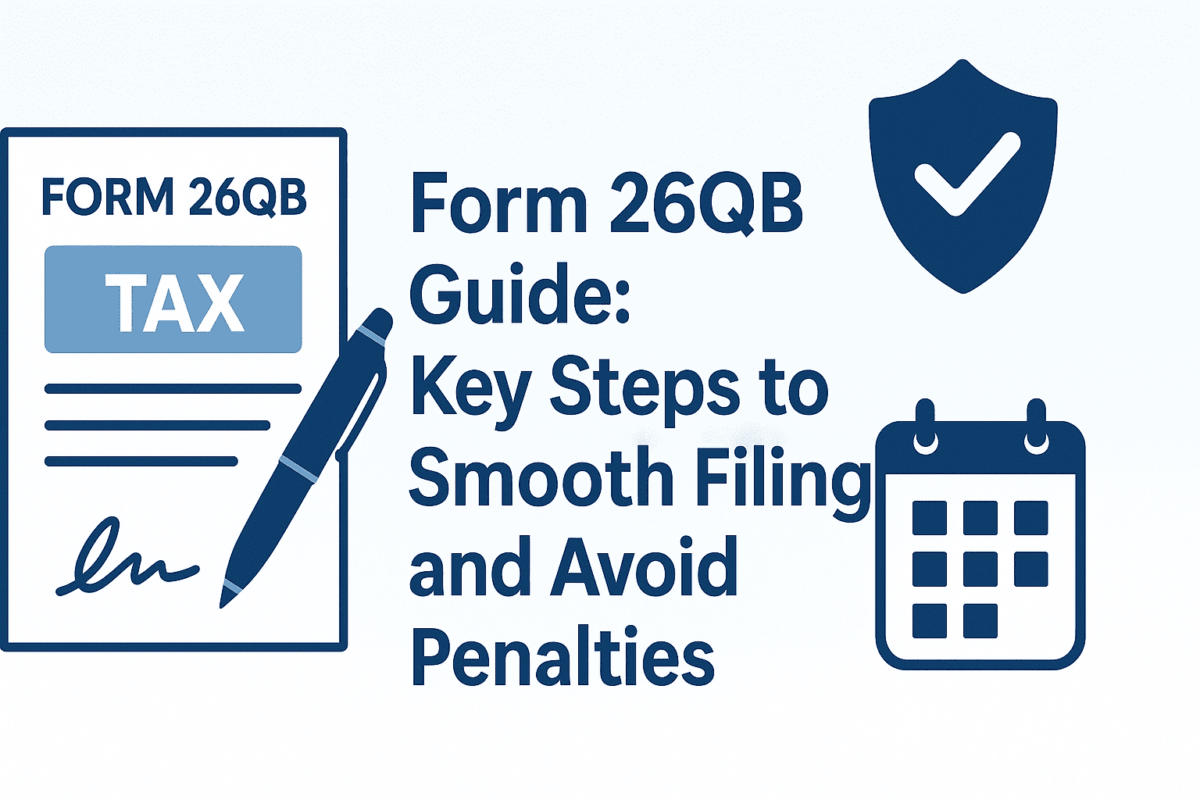Form 26QB Guide: Key Steps to Ensure Smooth Filing and Avoid Penalties

When purchasing immovable property in India, buyers are required to comply with the tax laws related to Tax Deducted at Source (TDS). One of the key compliance documents for property buyers is Form 26QB, a TDS return that must be filed by the buyer when the property transaction amount exceeds Rs. 50 lakh. Filing Form 26QB accurately and on time is crucial to avoid penalties and ensure a smooth transaction process. This guide provides a detailed walkthrough of the steps involved in filing Form 26QB and highlights the common mistakes to avoid in order to stay compliant with tax regulations.
What is Form 26QB?
Form 26QB is a TDS return form used by the buyer of an immovable property to report the tax deduction made on the transaction under Section 194-IA of the Income Tax Act. According to this provision, if the sale price of the property is Rs. 50 lakh or more, the buyer is required to deduct 1% TDS on the sale amount and file Form 26QB.
For instance, if you are purchasing a property worth Rs. 70 lakh, you would need to deduct 1% of the sale consideration, which is Rs. 70,000, and report it through Form 26QB.
Why is Filing Form 26QB Important?
Filing Form 26QB is crucial for several reasons:
- Legal Compliance: It ensures that the buyer meets the TDS requirements stipulated by the Income Tax Department.
- Avoiding Penalties: Failing to file Form 26QB or make the necessary TDS payment on time can lead to penalties and interest charges.
- Issuing TDS Certificate (Form 16B): After filing Form 26QB, the buyer can generate Form 16B, which acts as a TDS certificate for the seller. This certificate is important for the seller to claim credit for the TDS deducted.
- Ensuring Transparency: Filing the form ensures transparency in the transaction, which benefits both the buyer and seller by making the transaction tax-compliant.
Step-by-Step Guide to Filing Form 26QB
Filing Form 26QB is a straightforward process, but it requires attention to detail to ensure it is done correctly. Here’s a step-by-step guide to help you file the form smoothly and avoid penalties:
Step 1: Gather All Required Documents
Before starting the filing process, gather the following documents:
- Buyer’s PAN number: This is necessary for identification and filing the form.
- Seller’s PAN number: The seller’s PAN will be required for reporting the TDS deduction.
- Sale Consideration: The total value of the property being purchased.
- Property Details: The address and other relevant details about the property.
Having all the required information will make the filing process quicker and more accurate.
Step 2: Register or Log in to the Income Tax e-Filing Portal
To file Form 26QB, you must have an account on the Income Tax e-filing portal (https://www.incometax.gov.in/iec/foportal/). If you don’t have an account, you will need to create one by providing basic details like your PAN, mobile number, and email ID. If you already have an account, simply log in using your credentials.
Step 3: Select Form 26QB
Once logged in, navigate to the e-Filing section and select “TDS on Property” under the option to file Income Tax Forms. From there, choose Form 26QB to begin the filing process.
Step 4: Enter Buyer and Seller Details
In this section, you will be required to fill in the following details:
- Buyer’s Details: Enter the buyer’s PAN, name, and address.
- Seller’s Details: Enter the seller’s PAN, name, and address.
- Property Details: Provide information about the property being bought, including the sale price and address.
- Sale Consideration: Mention the total price of the property being purchased.
Ensure that all details are accurate to avoid errors in the filing process.
Step 5: Calculate and Enter the TDS Amount
Next, calculate the TDS amount, which is 1% of the sale consideration. For example, if the sale consideration is Rs. 50 lakh, the TDS to be deducted would be Rs. 50,000. Enter this amount in the relevant field. Double-check the calculations to ensure that the TDS amount is correct.
Step 6: Make the TDS Payment
Once the form is filled out, you will be prompted to make the TDS payment. The payment can be done online through the NSDL portal using net banking or other payment methods. After successful payment, you will receive a payment confirmation receipt (Challan), which you should keep for your records.
Step 7: Submit Form 26QB
After making the payment, go back to the Form 26QB page and submit the form. Upon successful submission, an acknowledgment receipt will be generated. Download this receipt and keep it for your records as proof of filing.
Step 8: Generate and Provide Form 16B to the Seller
Once Form 26QB is filed and payment is made, you will be able to generate Form 16B, the TDS certificate. This certificate is proof that the TDS has been deducted and deposited with the government. It is essential to provide the seller with this certificate.
Common Mistakes to Avoid
Filing Form 26QB correctly is important to avoid penalties and issues with tax compliance. Below are some common mistakes to avoid:
- Incorrect PAN Details: Ensure that both the buyer’s and seller’s PAN numbers are entered correctly. Incorrect PAN details can lead to a delay in processing or cause the form to be rejected.
- Mismatched Sale Consideration: Double-check that the sale price entered in Form 26QB matches the actual sale agreement. Discrepancies can lead to complications during verification.
- Delayed TDS Payment: Ensure that the TDS payment is made on time. Delayed payments attract interest and penalties under Section 234E of the Income Tax Act.
- Not Issuing Form 16B to the Seller: Don’t forget to provide Form 16B to the seller after filing Form 26QB. It’s their right to claim credit for the TDS deducted.
Penalties for Non-Compliance
Failing to file Form 26QB or making incorrect TDS payments can result in penalties and interest charges. Here’s what you need to know about penalties:
- Late Filing Fees: Under Section 234E, a penalty of Rs. 200 per day may apply for each day the TDS return is delayed.
- Interest on Late Payment: If the TDS is paid after the due date, interest is charged at the rate of 1% per month (or part of a month) from the due date of the payment until the actual payment date.
Conclusion
Filing Form 26QB is a vital part of property transactions for buyers in India. By following the steps outlined in this guide, you can ensure that the TDS is deducted and reported correctly, avoiding penalties and ensuring a smooth property transaction. Always double-check your entries, ensure timely payment, and issue Form 16B to the seller to stay compliant with tax regulations. By staying organized and diligent, you can master Form 26QB and complete your property transactions with confidence.









